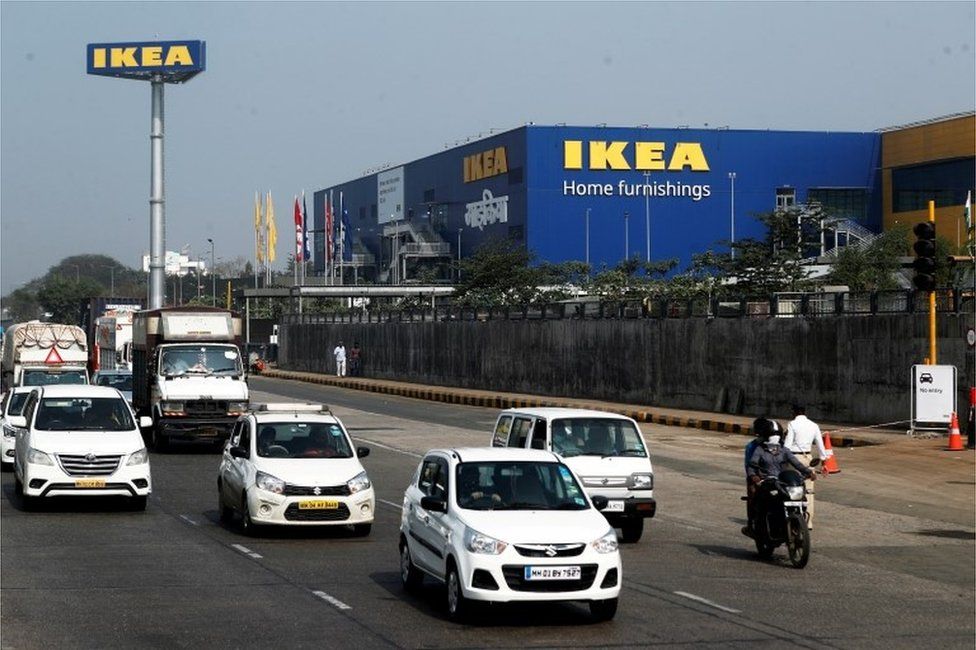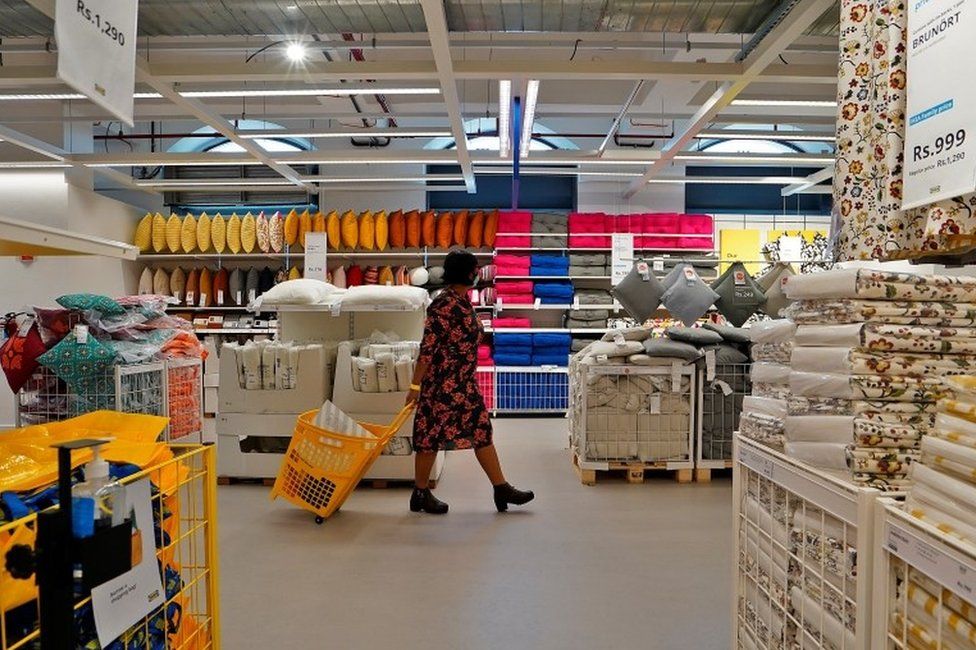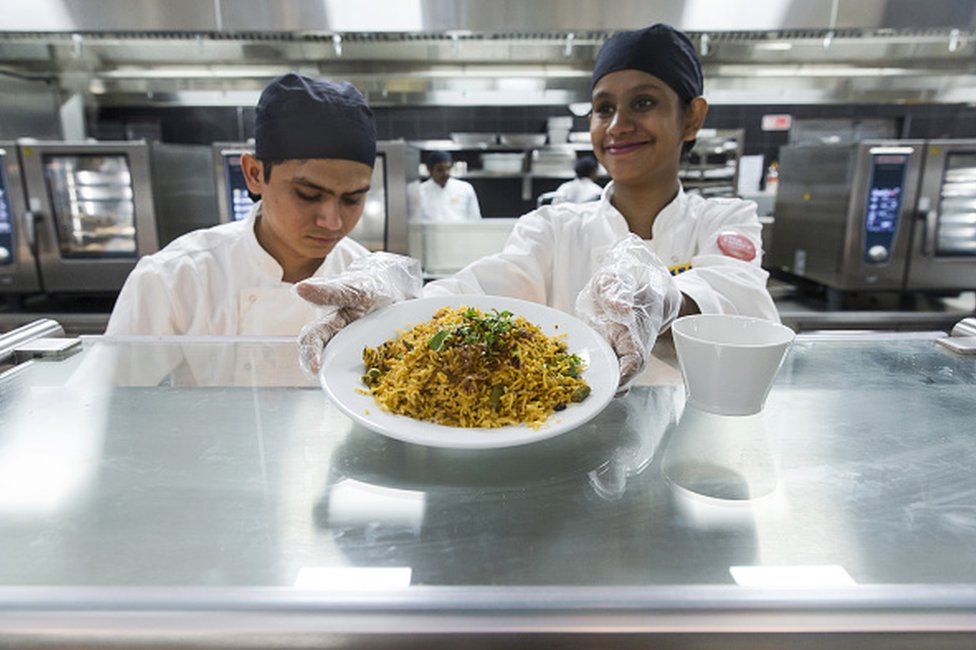Ms Mandlik ordered study tables, stools, lamps, a carpet, dishes and glassware for her one-bedroom apartment. The Swedish furniture giant, which opened in India in 2018, operates large-format stores in two cities and offers online shopping in seven, including Ahmedabad.
When guests come, Ms Mandlik joins the two study tables to make a dining table for eight. White, beige and grey dominate the colour palette of her new home. It reminds her of the 18 months she spent in London in a shared Kensington apartment, pursuing a masters in design research from the Royal College of Art.
“My tastes in furniture have changed completely over the years. And for some reason, Ikea seems to fit my new aesthetics,” says Ms Mandlik, an architect who teaches at India’s prestigious National Institute of Design.
She grew up in a sprawling joint family home in the western city of Aurangabad. Most of the furniture was heavy: teakwood sofas and chairs, glass-top dining tables, bulky metal folding chairs. Bric-a-brac picked up by her parents during holidays – lamps, baubles, miniature wooden boats, masks – also took up space. “Now families and spaces are getting smaller, and mobility has gone up. The way my generation looks at furniture has changed,” the 35-year-old architect says.
This was possibly one reason that encouraged Ikea to set sail for one of the world’s most complex furniture markets. Here antique furniture is handed down as a family heirloom; bespoke furniture continues to be made by carpenters; and tens of thousands of unorganised small outlets offer a more modern range that they assemble and deliver swiftly.
 IMAGE SOURCE,REUTERS
IMAGE SOURCE,REUTERSIndia’s $40bn (£29bn) “home and living” market – of which furniture and furnishings is a big component – is mainly powered by the country’s middle class. Ikea believes it is slowly making inroads – many of the 8,500-odd products on sale at its two 430,000 sq ft stores in Hyderabad and Mumbai, and online, are tailored and tweaked to suit Indian consumers. “Ikea is not in a hurry. They are all about creating and expanding an organised, price-sensitive, modern retail furniture market for India,” said Ankur Bisen, senior vice-president at Technopak, a consultancy.
A third of Ikea’s range in India changes every year and a quarter of its products on sale are locally sourced, according to Kavitha Rao, Ikea India’s chief commercial officer. “As a market, India always holds surprises for any global retailer. It is price-sensitive and you have to work across consumers in each category.”
So, Ikea here sells its cheapest sofa at 10,000 rupees ($134; £98) and its most expensive one at 125,000 rupees. A 19-rupee set of colourful spoons for children and a 99-rupee whiskey glass are among the lowest-priced items.
To better understand Indian consumers, Ikea visited more than 2,000 households with varying incomes in different cities. It placed furniture, home furnishing accessories and kitchens in many homes and tested them to see how they fared in the country’s hot, humid and dusty cities.
They found a splintered, heterogenous market.
 IMAGE SOURCE,REUTERS
IMAGE SOURCE,REUTERSThe average home in Hyderabad, for example, was double that of a home in Mumbai. So Ikea offered more vertical storage options in Mumbai, which has a lot of “small-space living”. Here, consumers were also more likely to buy a sofa-cum-bed – a sofa which can be converted into a bed.
In Hyderabad, consumers were likely to buy bigger sofas and more beds. The bedrooms on display at the stores in Hyderabad and Mumbai reflected these differences in space and size, according to Ms Rao. “Preferences and solutions are different in every Indian city,” she said.
Indians also preferred closed storage because of dust, so Ikea trimmed its vast range of open storage items and instead offered glass cabinets and cupboards.
The Indian kitchen threw up some surprises. Families typically eat four to five meals a day and use much more water while cleaning up in the kitchen. The retailer found that a lot of water was dripping off worktops in their modular kitchens, ruining the fronts of cabinets. So they came up with a “counter top block” or a slim ledge to stop the water from spilling over.
Just like Ikea made a lot of paella pans in Spain, it offered a range of pans, woks and stainless steel idli (steamed rice cake) steamers and cookers adapted to Indian cooking. Indians eat fairly elaborate lunches at work, so the retailer offered lunch boxes with three containers, and a combination pack, which included a water bottle.
The bedroom threw up a different challenge. Indians preferred to sleep on harder beds, so the retailer sold mainly locally made mattresses, some stuffed with coconut coir. A queen-size firm mattress – worth 19,000 rupees – is one of Ikea’s biggest selling products in India.
 IMAGE SOURCE,GETTY IMAGES
IMAGE SOURCE,GETTY IMAGESBut with a growing number of middle class Indians travelling abroad, consumers are also warming up to Ikea’s ethos. Although the retailer hires assemblers, more and more shoppers are taking flatpacks home and proudly recording their efforts at assembling on Instagram. Ikea has been catering to local taste buds – biryanis, samosas, vegetarian meatballs – in its popular cafeterias from the start. But the salmon filet in red curry and the salmon biryani are also a big draw. “We call it the Swedish desi-food,” Ms Rao muses.
More stores are expected to come up in Bangalore and in Delhi, and their suburbs, as the furniture giant steams ahead with its $1.5bn investment in India. Footfalls have risen to several million a year, and up to 60 million visitors shopped online in 2021.
Ikea launched online in Mumbai in 2019, the first time the furniture giant had done so before opening a store in any city in the world. Today, a fourth of its sales are online. While sales have grown, profits are some distance away. Ikea believes it wants to know more about how Indians socialise, entertain, sleep and eat. “This is a journey with no end,” Ms Rao said. “We have just about scratched the surface in India.”
Shoppers have been enthusiastic. Jayasree Anumolu, a 67-year-old Hyderabad-based homemaker, has taken her 95-year-old wheelchair-bound mother shopping to Ikea. “She was so excited!” Ms Anumolu said. At the store, they picked up knives, spoons, pots, pans, gift boxes and bowls. “We picked up things for ourselves, we picked up stuff to gift to others.”
Ms Anumolu also chose the furniture for her teenage grand-daughter’s room – “One of the tables has eight drawers. Eight!” she exulted. When her friends come visiting from out of town, they want to go on a three-hour-long jaunt of the local Ikea store rather than visit the magnificent ruins of the city’s iconic Golconda Fort. “Ikea is a craze!”.


